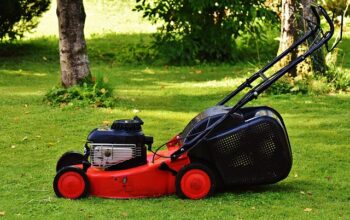Effective lawn care and landscaping require a deep understanding of soil science, climate-appropriate turf selection, and sustainable maintenance practices to cultivate a vibrant outdoor space. Key practices include precision mowing for grass health, Integrated Pest Management (IPM) for ecological balance, and precise fertilization informed by soil testing to minimize environmental impact. Advanced irrigation systems ensure efficient water use while contributing to the overall resilience of the lawn. By integrating these methods, professionals can create a visually appealing and environmentally responsible landscape that supports biodiversity and reduces reliance on chemicals. Additionally, incorporating native plants and natural fertilizers not only enriches the soil but also attracts pollinators and promotes a self-sustaining ecosystem. This holistic approach to lawn care and landscaping aligns with sustainable land management practices, enhancing both the aesthetic appeal and ecological value of your property.
Embark on a journey through the intricacies of lawn care and landscaping with our comprehensive guide. Uncover the fundamentals that form the bedrock of healthy turf, explore advanced techniques for optimal turf management, and learn how to integrate eco-friendly practices into your routine. This article is designed to equip you with the knowledge needed to maintain a lush, vibrant lawn, while also being mindful of environmental stewardship.
- Understanding the Fundamentals of Lawn Care and Landscaping
- Advanced Techniques for Optimal Turf Management
- Integrating Eco-Friendly Practices into Your Lawn Care Routine
Understanding the Fundamentals of Lawn Care and Landscaping

Engaging in lawn care and landscaping requires a deep understanding of the various factors that contribute to a thriving landscape. The fundamentals of lawn care encompass a range of practices from soil analysis to selecting the appropriate turfgrass varieties for local climate conditions. A healthy lawn begins with knowing your soil type, pH levels, and the nutrients required for optimal grass growth. Regular aeration, overseeding, and proper irrigation are key components that support a lush and resilient turf. Landscaping goes beyond mere grass care; it involves designing outdoor spaces to enhance both aesthetic appeal and ecological function. Understanding the balance between sunlight, water, and nutrient availability, along with the integration of diverse plantings, can significantly improve the overall health of your lawn. Effective lawn care and landscaping strategies not only create a visually pleasing environment but also contribute to biodiversity and soil health, which are essential for maintaining a sustainable ecosystem within your property boundaries. By mastering these fundamentals, homeowners and professionals alike can achieve and sustain a lawn that is both beautiful and resilient to the challenges posed by varying environmental conditions.
Advanced Techniques for Optimal Turf Management

Maintaining a lush, healthy lawn requires a deep understanding of advanced turf management techniques, which are pivotal in landscape care and professional landscaping. Expert turf managers employ a variety of sophisticated methods to ensure optimal grass health and resilience. These include precision mowing, which involves cutting the grass at the correct height for the specific type of turf, promoting root growth and maintaining density. Additionally, Integrated Pest Management (IPM) strategies are employed to monitor and manage pests and diseases, minimizing chemical interventions while maximizing ecological balance. Soil sampling and analysis play a crucial role in understanding the nutrient needs of the turf, allowing for targeted fertilization that enhances grass vigor without unnecessary runoff into waterways. Advanced irrigation systems are also critical; they deliver precise amounts of water at optimal times to conserve resources while maintaining soil moisture levels for consistent growth. By leveraging these techniques, landscape professionals can create and maintain a lawn that is both aesthetically pleasing and environmentally responsible.
Integrating Eco-Friendly Practices into Your Lawn Care Routine

Incorporating eco-friendly practices into lawn care and landscaping not only contributes to a healthier planet but also fosters a more resilient and vibrant lawn. Homeowners and professionals alike are turning towards sustainable methods to maintain their turf, which include selecting the right grass varieties for the local climate, ensuring soil health through organic matter application, and employing water-wise irrigation systems to conserve water. By using natural fertilizers such as compost and fish emulsion, lawns receive the necessary nutrients without the environmental impact of synthetic chemicals. Additionally, practices like proper mowing height and frequency encourage grass root growth, leading to a thicker, more pest-resistant lawn that requires fewer pesticides. Integrating these ecological approaches not only aligns with sustainable land management principles but also promotes long-term soil fertility and biodiversity within the landscape.
Moreover, integrating native plants into the surrounding landscaping can create a more harmonious ecosystem, providing nectar for beneficial insects and pollinators while reducing the need for external inputs. Regular lawn care and landscaping maintenance should include mulching to suppress weeds, aerate the soil to improve oxygen and nutrient flow, and overseed bare patches to maintain a lush, green coverage year-round. These eco-conscious strategies not only enhance the aesthetic appeal of the lawn but also contribute positively to the local environment by supporting biodiversity and preserving natural resources.
Effective turf management is a blend of foundational lawn care practices and advanced techniques tailored to create and maintain healthy, vibrant landscapes. This article has delved into the intricacies of these practices, emphasizing the importance of eco-friendly approaches that not only foster lush turf but also safeguard our environment. By mastering the fundamentals of lawn care and landscaping, and adopting sophisticated turf management strategies, one can achieve both aesthetic beauty and ecological harmony in their outdoor spaces. Integrating sustainable practices into your routine is a commendable step towards responsible stewardship of our green environments. With the knowledge gleaned from this exploration of lawn care and landscaping, you are well-equipped to nurture not just a lawn, but a living space that thrives in harmony with nature.




